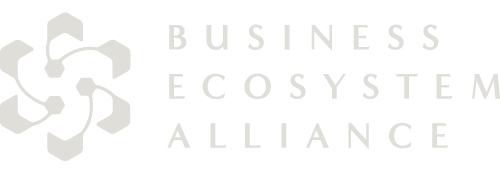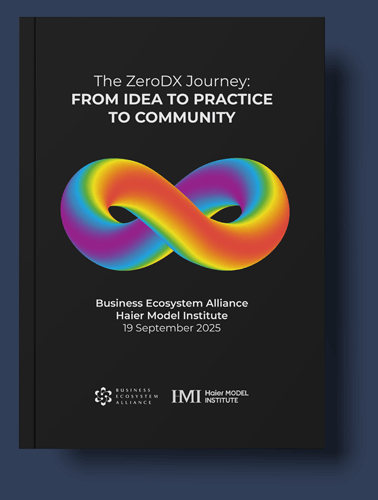How do digital ecosystems defend their business?
Özlem Bedre-Defolie
Many of the most valuable public companies, like Google, Alibaba, and Amazon, are digital platforms. Valuable startups, such as Airbnb, Spotify, and Uber, are also digital platforms. Some less-known names, like Raisin and SoundCloud, are among the fastest-growing startups, thanks to their business model that embraces a multisided platform (MSP). MSPs rely on attracting different user groups between which there are cross-group network effects. More buyers on Alibaba or on Amazon attract more sellers, and vice versa. More guests on Airbnb attract more hosts (listings), and vice versa. Sometimes these cross-group network effects can be negative from one side to the other. For example, more searchers on Google attract more advertisers, whereas if Google places too many sponsored search results, users who dislike ads might find Google search less valuable.
While enticing, launching an MSP is challenging as any new player needs to attract different user groups simultaneously. These user groups usually cannot coordinate their adoption decisions, resulting in the well-known coordination, or chicken-and-egg, problem.1 If the coordination problem erodes the number of users on one side, it reduces the number of users on the other side, and this spiral effect leads to loss of market share. This might potentially knock the entrant out of the market. As a result, network effects raise barriers to entry for platforms and might enable incumbents to protect their market even if the new platform offers better quality products/services. However, if the quality advantage of the entrant is sufficiently high, the incumbent might lose its users on one side, which would induce more losses on the other side. Thus, the incumbent might be quickly kicked out of the market due to network effects. For instance, Facebook’s entry pushed MySpace and others out of the market. IBM and Linux could not survive against Windows.
After a successful launch, MSPs look for ways to make network effects count. Incumbent platforms mostly try to protect their market power or become dominant by raising switching costs endogenously.
Increasing dominance of digital ecosystems
Most MSPs prefer to become digital ecosystems by acquiring or investing in complementary segments. For instance, Apple launched as a hardware firm and then became a two-sided platform when it started allowing third-party apps on its app store, where Apple enables interactions between third-party app providers and users of Apple products. Recently, Apple has moved towards providing additional services to its main products, such as Apple Music and Apple Card (in cooperation with Goldman Sachs).
Google started as an engineering firm focused on good quality internet search. Google then became a two-sided platform by adding advertisers and enabling interactions between advertisers and searchers. Thereafter, Google started to offer an advertising platform (formerly Google AdWords, now Google Ads) that connects third-party websites to Google advertising. Google also added other services including Gmail, Google Maps, YouTube, Google Cloud Platform, Google News, Google Calendar, and Google Nest.
Facebook was launched as a social media platform connecting students to their peers in university dorms. It then became an MSP by adding advertisers, app developers, and third-party websites. Facebook now offers other services via WhatsApp, Instagram, and Facebook Marketplace.
Amazon moved from a book retailer model to a marketplace model enabling buyers and third-party sellers to interact. Amazon now offers its Prime Video streaming services, Amazon Web Services, and more. Combining a variety of services within the ecosystem attracts more users (searchers/buyers) on one side and this attracts more users (advertisers/sellers) on the other side via positive cross-group network effects, increasing the revenue generated by the ecosystem.
These digital ecosystems offer many benefits to consumers, mostly at zero or subsidized prices (prices below cost). Consumers usually use one platform (single-homing) for a variety of services and enjoy the benefits of network effects. The Cournot effect says that a monopoly of complementary goods sets lower prices than competitive supply. This suggests the ecosystem owner (the platform) charges lower prices for each service than where each service is offered by independent competing firms.
This logic is not as simple as it sounds, since these are not standard firms; they are MSPs balancing the participation of different user groups when pricing them and with cross-group network effects between these groups. Besides, personalized data improves the quality of services/products offered by these ecosystems (search, recommendation systems, matching, etc). Consequently, digital ecosystems become more valuable as they lock in more users. As a result of these positive economies of scale on the demand side, we now have few dominant platforms – Google, Amazon, Facebook, Apple, and Microsoft, also known as GAFAM – controlling the options for nearly everything we do.
Increasing antitrust concerns and interventions
Digital platforms’ innovative business models have enabled them to offer many valuable services to users, but have challenged policy makers2. This has led to significant antitrust and regulatory scrutiny and interventions, both in the EU and in the US. For instance, in digital markets the transparency of price and product information has enabled competing firms to use this information to shape their strategies. This has raised antitrust concerns, such as potential collusive behaviour via easy price monitoring, price and other forms of restrictions used by online trade platforms in their seller contracts, potential market sharing in e-commerce, and the possibility of an anticompetitive information exchange via online marketplaces3. There are also significant quality concerns in online markets and in sharing economies. Think of Uber. Platforms such as Amazon and Airbnb have already implemented reputation and trust mechanisms to increase quality. Some platforms, like Zalando, try to select their suppliers to ensure a minimum quality. However, the access rules of platforms might limit variety and raise anticompetitive concerns, in particular, if those platforms have significant dominance in the market. The European Commission’s 2019 expert report states: “dominant platforms have regulatory power and have a responsibility to use that power in a pro-competitive manner.”4 In June 2019, US lawmakers started investigating GAFAM’s potential abuse of their dominance.5
Abuse of dominant power might lower quality, variety, and innovation.
A dominant platform might find it profitable to impede an entry by a more innovative, better quality, or more efficient rival platform. For instance, when a dominant platform offers a variety of complementary products/ services or loyalty discounts, it endogenously increases switching costs for its users and hence lowers the chances of a new entrant challenging its incumbency position. Exclusive dealing provisions with high quality providers might also raise entry barriers by giving competitive advantage to the incumbent firm6, but entrants might also benefit from exclusive dealing provisions. By locking sellers of high quality content/products into an exclusive dealing contract, an entrant might be able to overcome the chicken-and-egg problem. Research by Robin Lee found that banning exclusive dealing contracts hurts entrant video game platforms and benefits incumbents.7
Hybrid digital platforms, like Apple, Amazon and Zalando, are online marketplaces enabling transactions between buyers and sellers (app developers and users), and at the same time they are sellers of their own products – as with Amazon/Zalando selling their own products as retailers or Apple selling its own services in its App Store. One way an incumbent platform could generate competitive advantage against its downstream third-party provider is by favouring its own downstream business. In 2017, the EU fined Google $2.7 billion for favouring its shopping service in search results. Amazon might produce its version of successful third-party products and set higher commissions/exclude sellers of these products (also the subject of an ongoing investigation). An investigation found that Amazon uses third party sellers’ product information when developing its own products.8 Apple’s entry into music services might imply higher commissions or worse terms for high quality service providers. In March 2019, Spotify, a music streaming platform, filed an EU antitrust complaint against Apple due to “unfair terms” that Apple tried to impose on Spotify’s premium subscription sales via Apple’s App Store.9
In the future, more dominance will bring more regulation if it is abused. All these developments and the evolution of digital markets suggest that we will see more powerful digital ecosystems that will try to protect their dominance by raising users’ switching costs via different mechanisms. If dominant ecosystems focus on quality, variety, and innovation they can sustain their dominance in the long run without hitting regulatory hurdles, costly antitrust interventions, or loss of reputation among their loyal users. However, if they play dirty by using their dominance to hinder a more innovative, efficient, and better-quality rival from the market, they will sooner or later face more regulation and more antitrust scrutiny. Their loyal customers might also find these tactics unfair and switch to an alternative platform/ecosystem that cares more about offering the highest quality with the best user conditions. If there is no available alternative, the business strategies of dominant digital platforms might give rise to more dramatic regulations, including breaking their business units into independent companies.
Özlem Bedre-Defolie is an Associate Professor of Economics at ESMT Berlin.
Footnotes:
1 Bernard J. M. Caillaud and Bruno Jullien, “Chicken & egg. Competition among intermediation service providers,” RAND Journal of Economics 34(2): 309–328, 2003.
2 See the European Commission’s 2017 e-commerce report, The Federal Trade Commission’s 2016 report on the sharing economy and the OECD’s 2018 note on e-commerce.
3 Some platforms, like Amazon and Zalando, have hybrid business models, that is, they are marketplaces connecting sellers and buyers, and at the same time retailers of Germany’s competition authority, Bundeskartellamt, is currently investigating whether information sharing between these two functions might be anticompetitive; http://www.faz.net/aktuell/wirtschaft/andreas-mundt-endspiel-um-die-telekommunikation-15725311.html.
4 Jacques Cremer, Yves-Alexandre de Montjoye, Heike Schweitzer, “Competition Policy for the Digital Era,” European Commission, 2019.
5 https://www.theguardian.com/technology/2019/jun/03/tech-monopoly-congress-increases-antitrust-scrutiny-on-facebook-google-amazon
6 Özlem Bedre-Defolie and Gary Biglaiser, “Platform Competition for Exclusivity with a Marquee Seller,” mimeo, 2020.
7 Robin Lee, “Vertical integration and exclusivity in platform and two-sided markets,” American Economic Review, 103(7), 2013, pp. 2960–3000.
8 https://www.cnbc.com/2020/04/23/wsj-amazon-uses-data-from-third-party-sellers-to-develop-its-own-products.html
9 https://www.reuters.com/article/us-apple-spotify-tech-eu/spotify-files-eu-antitrust-complaint-against-apple-idUSKBN1QU18G


